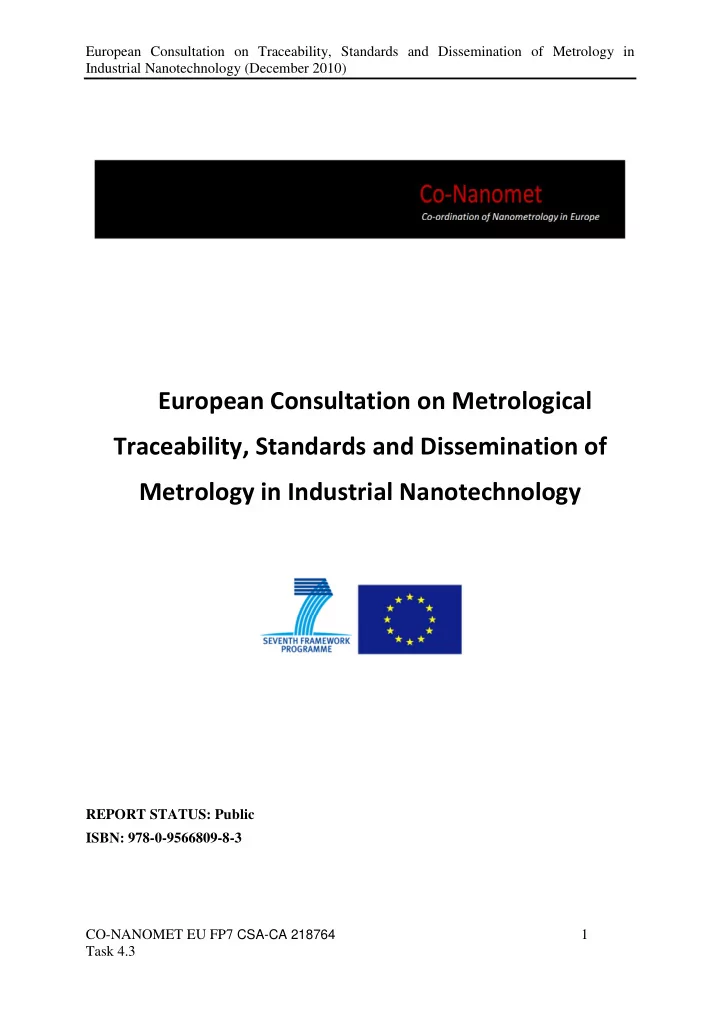

European Consultation on Traceability, Standards and Dissemination of Metrology in Industrial Nanotechnology (December 2010) European Consultation on Metrological Traceability, Standards and Dissemination of Metrology in Industrial Nanotechnology REPORT STATUS: Public ISBN: 978-0-9566809-8-3 CO-NANOMET EU FP7 CSA-CA 218764 1 Task 4.3
European Consultation on Traceability, Standards and Dissemination of Metrology in Industrial Nanotechnology (December 2010) European Consultation on Metrological Traceability, Standards and Dissemination of Metrology in Industrial Nanotechnology Leslie Pendrill 1 , Olena Flys 1 , Kai Dirscherl 2 and Gert Roebben 3 , 1 SP Sveriges tekniska forskningsinstitut, Sweden, 2 Danish Fundamental Metrology, Denmark 3 Institute for Reference Materials and Measurements, Joint Research Centre, European Commission Leslie.pendrill@sp.se Executive Summary It is widely acknowledged that the industrial exploitation of nanotechnology through innovative products is still lagging, in particular in Europe, despite advances in nanosciences. During 2010, in support of sustainable growth in the nanomanufacturing 1 industry, a CO- NANOMET [EU FP7 CSA-CA 218764 ] consultation has been made of both the means and content of the dissemination of the particular metrology tools and know-how needed in the nanotechnology workplace. In this consultation, and in this corresponding report, these tools and know-how are covered by the term "nanometrology", which is short for "metrology at the nanoscale" and includes metrological traceability, measurement uncertainty and standardised measurement definitions and methods. Programmes encouraging industry to innovate by exploiting nanometrology through local networking and through various documentary standards (i.e. written standards, i.e. norms) are found to be promising means of disseminating nanometrology to industry. These are two examples of how a European innovation infrastructure can provide support throughout the innovation process – from initial idea, through design, manufacture, conformity assessment and marketing – through to the finished product. An innovation infrastructure in nanometrology will network and integrate actors in each field – from policy makers to metrologists - so that these can work together to tackle the major challenges. During the consultation, the five European CO-NANOMET action groups in nanometrology (ENAG): Engineered Nanoparticles; Nanobiotechnology; Thin Films and Structured Surfaces; Critical Dimension and Scanning Probe Techniques; and Modelling and Simulation, have made recommendations of the future needs for A) Documentary standards; B) Measurement methods; and C) Metrological requirements, particularly proposed intercomparisons, as follows: A) Documentary standards 1 Nanomanufacturing: intentional synthesis, generation or control of nanomaterials, or fabrication steps in the nanoscale, for commercial purposes; ISO/TS 80004-1:2010. CO-NANOMET EU FP7 CSA-CA 218764 2 Task 4.3
European Consultation on Traceability, Standards and Dissemination of Metrology in Industrial Nanotechnology (December 2010) Documentary standards are developed in nanotechnology, as elsewhere, to provide a harmonised and unambiguous framework to enable nanomanufacturing both in the regulatory context, for instance, where there are perceived risks with nanotechnology, but also to ensure general product quality and conformity compliance to facilitate trade, to promote customer satisfaction, and to improve production sustainability. Two main challenges for metrology in standardisation, including nanometrology, to be addressed are: Documentary standards sometimes make reference unfortunately to unrealistic and ambiguous measurement specifications and unclear requirements. Suggested actions: written standards should be checked against a "metrology checklist"; written standards describing new measurement procedures should be validated by an interlaboratory comparison before their release. Industry and society are placing increasingly exacting demands on measurement in terms of complexity and accuracy, including meeting ‘grand challenges’ such as in energy & the environment, health & safety amongst others, employing nanotechnology. Suggested action: There is a need for more pre-normative R&D into the metrological aspects of measurement and product norms for nanotechnology. Significant contributions are needed to pre-normative research, in developing the necessary metrological aspects at all steps in product development – from initial product design and specification, through metrological design, procurement and actual measurement, to final product conformity assessment and marketing. B) Measurement methods Recommended, standardised measurement methods are needed in support of measurement quality assurance of laboratories making measurements in the workplace. Product quality is very much determined by the quality of the measurements made to test against specifications. Examples of challenges in developing measurement methods at the nanoscale include: - The need for new measurement instruments and methods working at the nanoscale; - New characteristics unique to the nanoscale need to be measured; - Measurements need to be made in challenging environments, e.g. ultra-high vacuum. Suggested action: Continued support for research & innovation activities leading to the development of new and improved methods for measurement and testing at the nanoscale . C) Metrological requirements Metrological traceability – where possible to the universal measurement references of the SI system – ensures that measurement results made at different times and different locations can be compared objectively and reliably. CO-NANOMET EU FP7 CSA-CA 218764 3 Task 4.3
European Consultation on Traceability, Standards and Dissemination of Metrology in Industrial Nanotechnology (December 2010) Examples of metrological challenges at the nanoscale include: - Longer chains of metrological traceability; - The need for new nanoscale reference materials and physical standards. Meeting these challenges is often more demanding than can be achieved by individual actors, simply because all stages of the innovation process have to be covered at the same time as nanotechnology is rapidly developing. Suggested action: A strengthening is needed of the existing network of European measurement facilities as well as investments in the development and introduction of new standards and measurement techniques , as part of establishing the necessary infrastructure to support growth in nanotechnology and nanomanufacturing. Detailed tables for each area (A), B) and C)) are given in this report, for the different Co- Nanomet action groups (ENAGs). CO-NANOMET EU FP7 CSA-CA 218764 4 Task 4.3
Recommend
More recommend